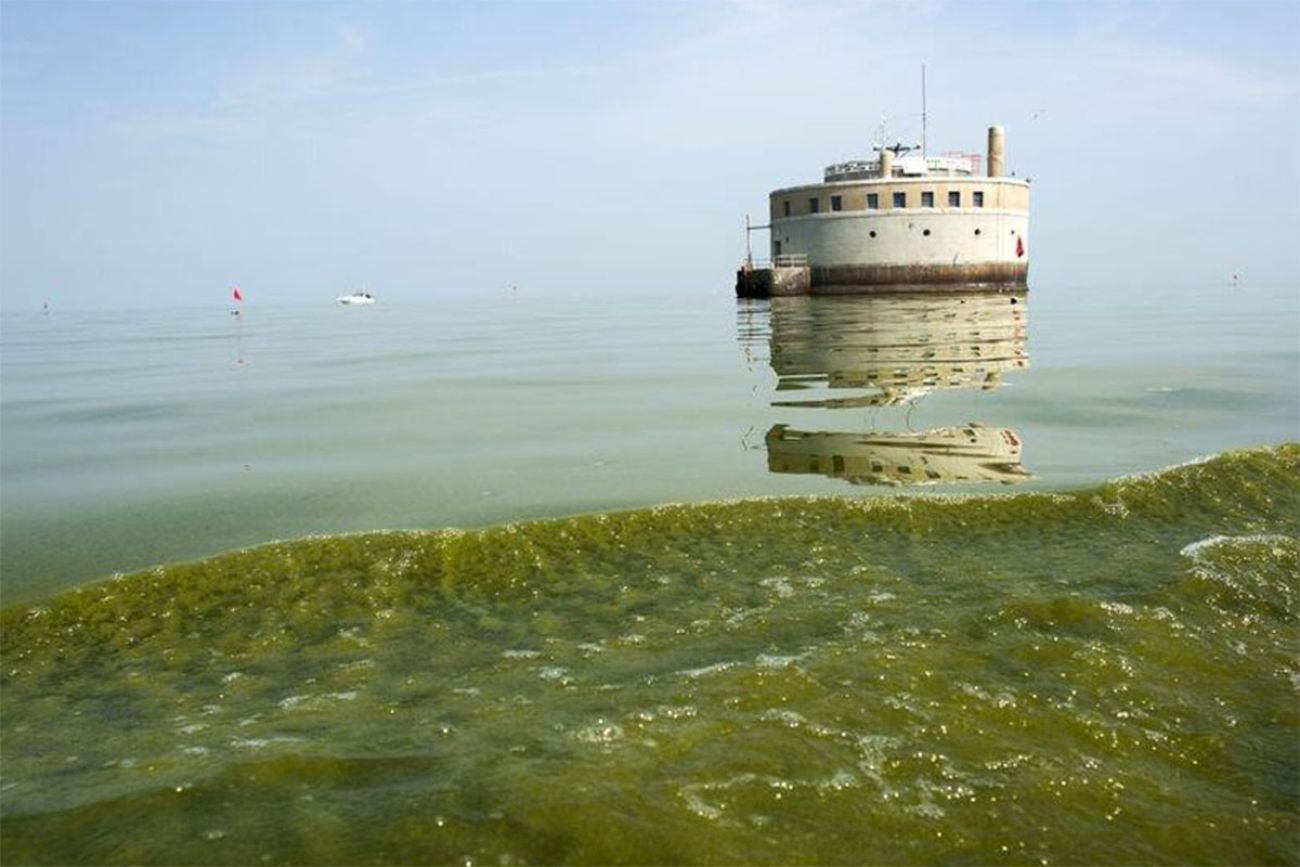How to protect pets during Michigan’s blue-green algae season

- Harmful blue-green algae fouls Michigan lakes, kills dogs and sickens humans
- The algae is caused by heat and excess nutrients, typically blooming from July to October
- If you visit Michigan beaches this summer, keep your dogs, kids and yourself out of green scum
July in Michigan is prime time for barbecues, beaches — and toxic algae that threatens people and pets.
Blue-green algae, or cyanobacteria, is a longstanding problem in Michigan waterways such as the Saginaw Bay and Lake Erie. Climate change and pollution are making it more of a problem in inland lakes and ponds.
Michigan has had 16 verified blue-green algae blooms this year, including in Lake St. Clair near Detroit, Gun Lake near Grand Rapids and Houghton Lake.
Two of the reported blooms, at Ore Lake and Bald Eagle Lake, tested positive for toxins. Meanwhile, the putrid stuff is fouling Lake Erie weeks ahead of schedule.
Related:
- Experts predict moderate Lake Erie toxic algae bloom
- Toxic Great Lakes algae makes Michigan sick. But remedy may be near
- Swim at your own risk: High E. coli count closes nine Michigan beaches
“The blooms are starting earlier, they’re lasting longer,” Sean Corson, director of the National Centers for Coastal Ocean Science, said during a recent webinar.
“They’re getting worse.”
Here’s how to identify toxic algae and keep yourself and your pets safe.
How blue-green algae causes illness
Not all blue-green algae is dangerous.
But under the right conditions, it can produce harmful toxins called cyanotoxins that harm the liver and kidneys.
Toxic algae nationwide sickened 117 people and 2,715 animals in 2021, according to the Center for Disease Control and Prevention. It’s not safe to touch, ingest or breathe droplets of algae-tainted water.
Blue-green algae thrives in warm, polluted water. And because climate change is making waters warmer than ever, the threat of algae blooms is growing.
When manure and fertilizer are spread too thick on farm fields, they get swept into rivers during rainfall, polluting the water with excess nutrients.
Those nutrients wind up feeding the algae instead of nourishing crops.
Lake Erie’s annual blooms got so bad in 2014, it entered the city of Toledo’s drinking water intake. City officials had to shut down the drinking water system, leaving 400,000 people without public water for three days.
This year brings ‘moderate’ bloom risk
Every summer, blue-green algae fouls hundreds of square miles of Lake Erie, the country’s most visible example of the risk.
This summer’s bloom is forecasted to be moderate, according to the National Center for Coastal Ocean Science (NCCOS).
Despite decades of effort and plenty of money spent responding to the farm pollution that fuels Lake Erie’s blooms, the situation hasn’t improved.
Environmental groups contend the only way to fix Lake Erie’s algae problem is to force farmers to use less fertilizer.
Instead, the state and federal government have favored a costly but so far ineffective program that pays farmers to temporarily adopt environmentally-friendly practices.
How to stay safe
If you plan on visiting the lake this summer, steer clear of stinky patches of green, blue or brown scum on the water’s surface.
Blue-green algae often looks like spilled paint or ink and smells putrid. Sometimes it forms in clumps and produces foam.
Unlike the harmless stringy filamentous algae that can be lifted from the water with a stick or paddle, blue-green algae clumps will break apart if you try to lift them from the water.
If you think you’ve spotted blue-green algae on the surface, “keep your kids, yourself and your pets out of the water,” said Richard Stumpf, a National Oceanic and Atmospheric Administration oceanographer.
If you or your pet come into contact, notify your doctor or veterinarian immediately.
You can report suspicious-looking algae to the Michigan Department of Environment, Great Lake and Energy.
Check the NCCOS website or the Michigan Department of Environment, Great Lakes and Energy’s algae bloom map for the latest bloom reports.
Some good news
While Michigan’s algae problems aren’t going away anytime soon, scientists are close to developing a preventative treatment to keep you and your pets healthy even if you’re exposed.
Michigan Environment Watch
Michigan Environment Watch examines how public policy, industry, and other factors interact with the state’s trove of natural resources.
- See full coverage
- Subscribe
- Share tips and questions with Bridge environment reporter Kelly House
Michigan Environment Watch is made possible by generous financial support from:
Our generous Environment Watch underwriters encourage Bridge Michigan readers to also support civic journalism by becoming Bridge members. Please consider joining today.
See what new members are saying about why they donated to Bridge Michigan:
- “In order for this information to be accurate and unbiased it must be underwritten by its readers, not by special interests.” - Larry S.
- “Not many other media sources report on the topics Bridge does.” - Susan B.
- “Your journalism is outstanding and rare these days.” - Mark S.
If you want to ensure the future of nonpartisan, nonprofit Michigan journalism, please become a member today. You, too, will be asked why you donated and maybe we'll feature your quote next time!






